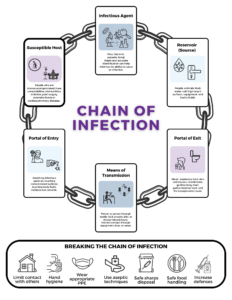Infection Prevention and Control
The CLPNA’s practice guideline supports LPNs in preventing the transmission of disease and infections, which promotes client and healthcare provider safety.
Infection Prevention and Control (IPC) is an integral part of nursing practice. IPC interventions are specific measures that are taken to prevent or minimize the spread of diseases in a practice environment.
LPNs are responsible for adhering to the CLPNA’s IPC guidelines and employer requirements.
Understanding the Chain of Infection
Communicable diseases spread through six unique chains of infection.
- Infectious agent: the microorganism or pathogen (e.g. bacteria, virus, parasite, or fungi).
- Reservoir (source): a host that allows the microorganism to live and possibly grow and multiply (e.g. environmental surfaces/equipment, body fluids like blood or saliva, urine/fecal material, food/water, soil, skin, people, or animals).
- Portal of exit: how the microorganism moves or escapes from the reservoir (e.g. blood, respiratory tract, skin and mucous membranes, genitourinary tract, gastrointestinal tract, or the transplacental route from mother to fetus).
- Means of transmission: how microorganisms move from one place to another. Some microorganisms cannot travel independently and require a vehicle to carry them to other people and places (e.g., person to person through bodily fluid, bite, or sharps-related injury; indirect contact through equipment, food, or water).
- Portal of entry: the path for the microorganism to enter a new host. This could include body openings (e.g. mouth, eyes, urinary tract, respiratory tract), incisions, or wounds.
- Susceptible host: a person (client or healthcare provider) susceptible to a microorganism (e.g., due to age, immunocompromised status, co-morbidities, nutrition, medications, diabetes, being post-operative, extensive burns, or cardiopulmonary diseases).
To prevent the transmission of disease and infection, LPNs must understand and follow IPC guidelines. The chain of transmission can be broken through the following means:
- limiting contact with others,
- using proper hand hygiene,
- wearing appropriate personal protective equipment (PPE),
- using aseptic techniques,
- disposing of sharps safely,
- handling food safely, and
- increasing defenses against infections and diseases.
Professional Responsibility and Accountability
LPNs must adhere to all legislation, regulations, standards of practice, and employer requirements for reporting infectious diseases and IPC protocol breaches.
Strategies for Maintaining IPC Professional Responsibility and Accountability
Use critical thinking and follow employer requirements when initiating, applying, or removing IPC precautions. All healthcare team members have a joint responsibility to maintain IPC measures. If IPC protocols are broken or disregarded, the appropriate authority should be informed to take corrective action.
Please see the CLPNA’s Duty to Report interpretive document for more information on reporting.
More strategies for maintaining professional responsibility and accountability are listed below.
- Direct any questions about practice or reporting requirements for IPC to the employer or the CLPNA.
- Promptly report concerns about a breach of IPC protocols to a supervisor or employer.
- Provide real-time education to colleagues, families, visitors, students, or others who might be breaching IPC protocols.
- Identify clients experiencing new symptoms and assess the need to initiate IPC protocols.
- Maintain competence in IPC best practices by seeking educational opportunities.


